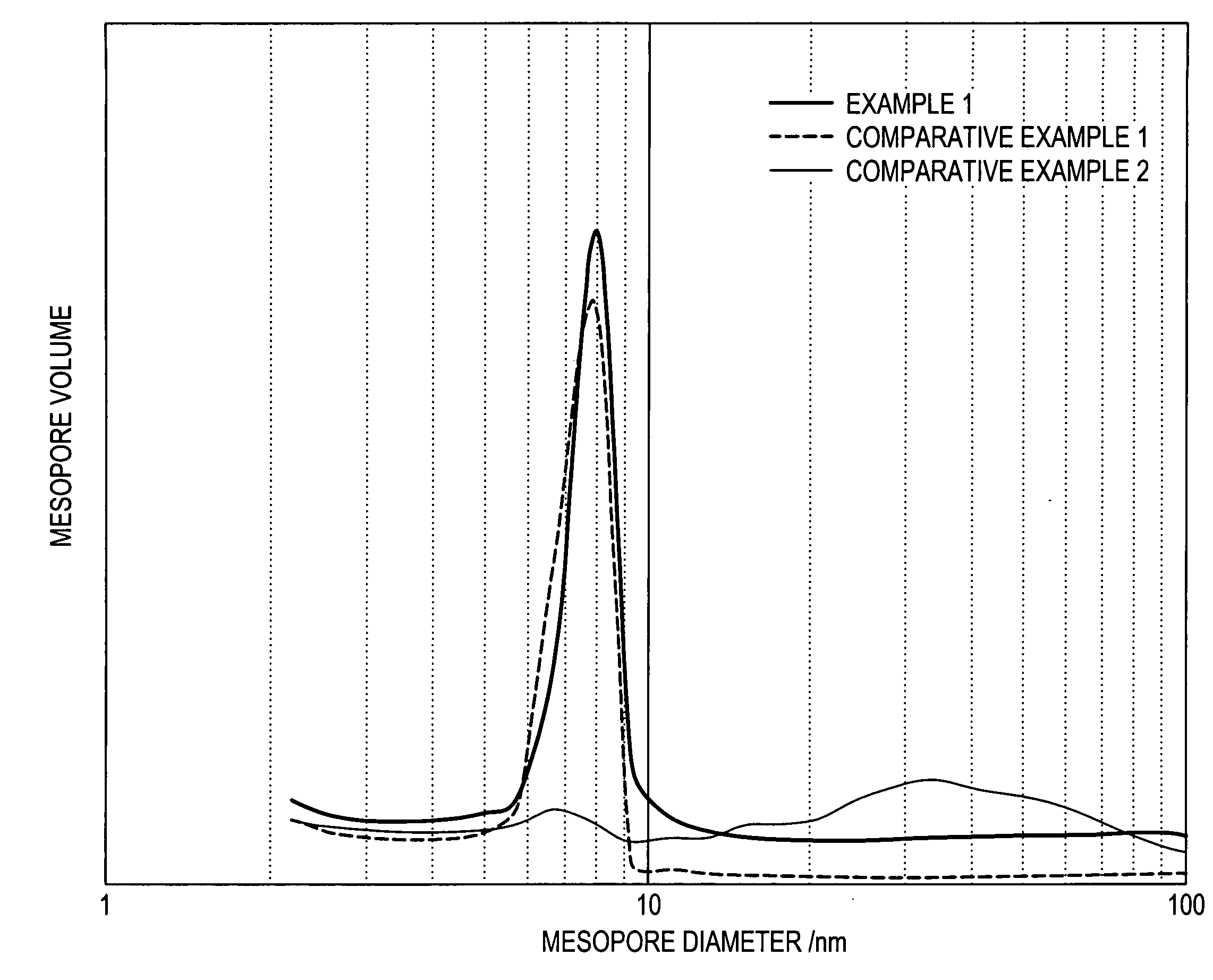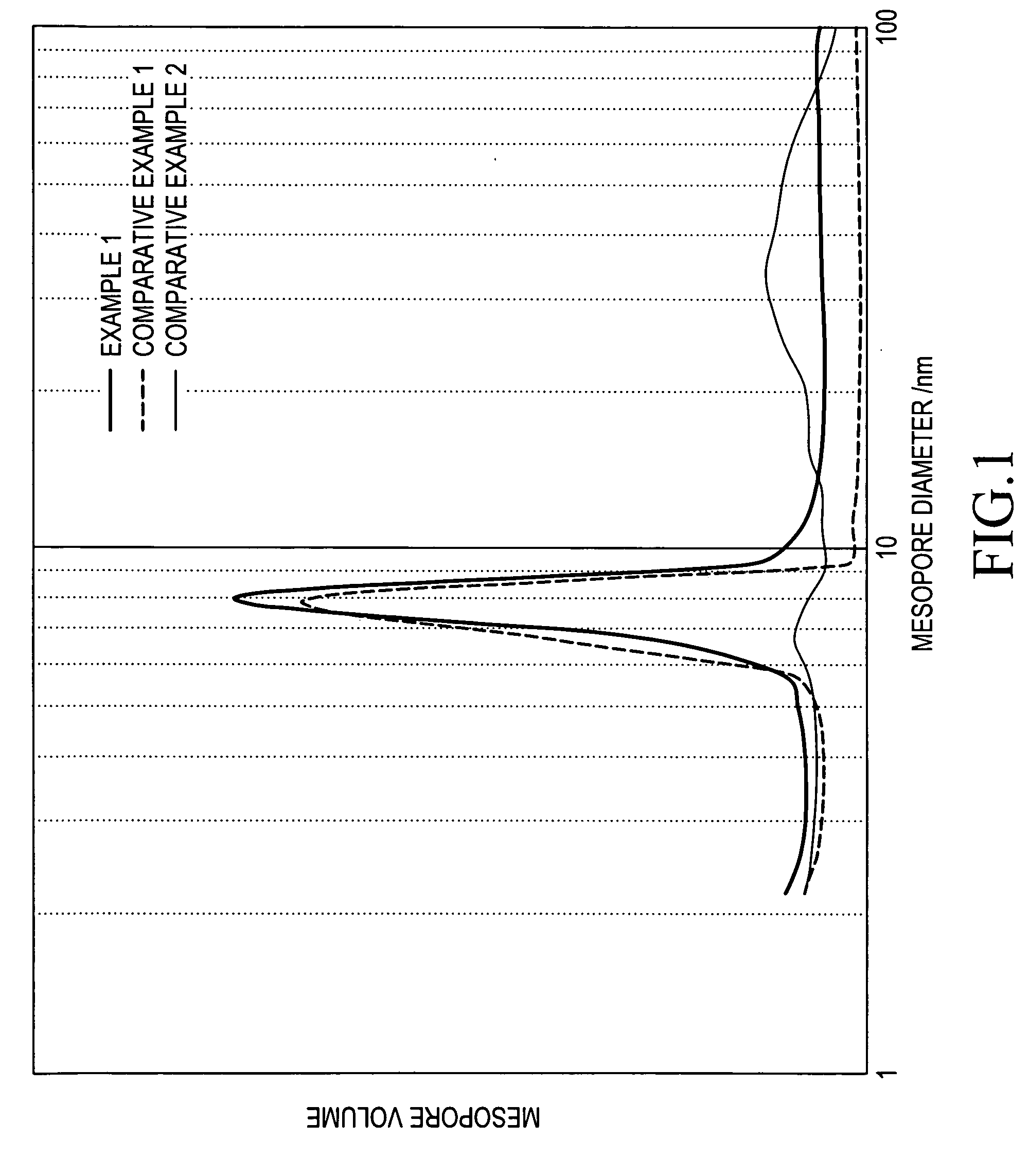Mesoporous silica particles and production process thereof
a technology of mesopore and silica particles, which is applied in the direction of physical/chemical process catalysts, silicon compounds, silicon oxides, etc., can solve the problems of reduced material value, difficult to use it as catalyst support or separation agent, and uniform mesopore size, etc., to achieve high yield and produce efficiently
- Summary
- Abstract
- Description
- Claims
- Application Information
AI Technical Summary
Benefits of technology
Problems solved by technology
Method used
Image
Examples
example 1
[0112]A block copolymer of ethylene glycol and propylene glycol (Pluronic-P123 of BASF Co., Ltd.) was dissolved in ion exchange water to prepare a 20 wt % surfactant solution. 150 g of the surfactant solution, 44 g of 25 wt % sulfuric acid and 73 g of ion exchange water were mixed together to prepare a transparent solution. 133 g of sodium silicate (containing 15 wt % of SiO2 and 5.1 wt % of Na2O) was added dropwise to this solution under stirring to obtain a cloudy reaction mixture. The pH of the reaction mixture was 2.7.
[0113]The reaction mixture was maintained at 30° C. for 1 hour under stirring, heated at 95° C. and maintained at that temperature for 12 hours to produce mesoporous silica particles having the surfactant existent in mesopores.
[0114]Thereafter, a polyethylene pot was filled with 390 g of the above reaction mixture and 1,520 g of zirconia balls having a diameter of 2 mm and sealed up without a dead volume in the pot to wet pulverize the mixture with a pot mill. The ...
example 2
[0131]A block copolymer of ethylene glycol and propylene glycol (Pluronic-F127 of BASF Co., Ltd.) was dissolved in ion exchange water to prepare a 10 wt % surfactant solution. 210 g of the surfactant solution, 59 g of 25 wt % sulfuric acid and 291 g of ion exchange water were mixed together to prepare a transparent solution. 140 g of sodium silicate (containing 15 wt % of SiO2 and 5.1 wt % of Na2O) was added dropwise to this solution under stirring to obtain a cloudy reaction mixture. The pH of the reaction mixture was 1.0.
[0132]The reaction mixture was maintained at 30° C. for 10 hours under stirring, heated at 80° C. and maintained at that temperature for 12 hours to produce mesoporous silica particles having the surfactant existent in mesopores.
[0133]Thereafter, part of the solution was removed from the above reaction mixture by decantation, and the content of the mesoporous silica particles in the reaction mixture was adjusted to 5 wt %.
[0134]A polyethylene pot was filled with 3...
example 3
[0151]A block copolymer of ethylene glycol and propylene glycol (Pluronic-P123 of BASF Co., Ltd.) was dissolved in ion exchange water to prepare a 20 wt % surfactant solution. 100 g of the surfactant solution, 44 g of 25 wt % sulfuric acid and 123 g of ion exchange water were mixed together to prepare a transparent solution. 133 g of sodium silicate (containing 15 wt % of SiO2 and 5.1 wt % of Na2O) was added dropwise to this solution under stirring to obtain a cloudy reaction mixture. The pH of the reaction mixture was 2.7.
[0152]The reaction mixture was maintained at 30° C. for 10 hours under stirring to produce mesoporous silica particles having the surfactant existent in mesopores.
[0153]Thereafter, a polyethylene pot was filled with 390 g of the above reaction mixture and 1,520 g of zirconia balls having a diameter of 2 mm and sealed up without a dead volume in the pot to wet pulverize the mixture with a pot mill. The amount of the surfactant existent in the mesopores was 100 part...
PUM
| Property | Measurement | Unit |
|---|---|---|
| particle diameter | aaaaa | aaaaa |
| diameter | aaaaa | aaaaa |
| size | aaaaa | aaaaa |
Abstract
Description
Claims
Application Information
 Login to View More
Login to View More - R&D
- Intellectual Property
- Life Sciences
- Materials
- Tech Scout
- Unparalleled Data Quality
- Higher Quality Content
- 60% Fewer Hallucinations
Browse by: Latest US Patents, China's latest patents, Technical Efficacy Thesaurus, Application Domain, Technology Topic, Popular Technical Reports.
© 2025 PatSnap. All rights reserved.Legal|Privacy policy|Modern Slavery Act Transparency Statement|Sitemap|About US| Contact US: help@patsnap.com


